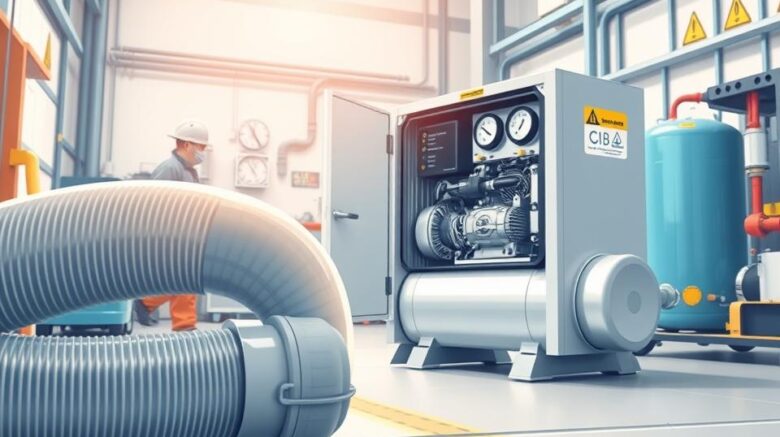Everything You Need to Know About PVC Air Compressor Piping
You might be surprised to learn that a failure in a compressed air system can unleash power on par with dynamite. Despite the hazards, numerous workshops continue installing piping systems from unsafe materials. Read on to discover why PVC air hose choices demand top-tier safety.
Although some plastics gain popularity, OSHA flatly forbids their above-ground application. Oil contact and repeated temperature swings degrade these pipes, risking sudden ruptures. Safe-rated pressures can still result in deadly bursts.
For reliable alternatives, Installation Parts Supply offers durable solutions like aluminum. Using approved materials saves you from fines and enhances safety. Here’s how to assemble a risk-free system.

Essential Conclusions
- OSHA prohibits specific piping for air lines because of blast hazards.
- Temperature changes can halve pressure ratings.
- Long-term exposure makes pipes prone to brittle breaks.
- Aluminum lines deliver a far safer option.
- Spending on correct materials avoids penalties and injuries.
Why You Shouldn’t Use PVC for Compressed Air
PVC makers caution never to employ it in high-pressure air setups. Compressed air carries destructive energy; a burst is like a dynamite blast. Material selection is the linchpin of air-system safety.
- Brittleness: Sub-freezing temperatures turn materials brittle, increasing fracture risks.
- Adhesive failures: Joints weaken when exposed to compressor oils or temperature swings.
- Misleading ratings: Pressure capacity drops 50% at 110°F—most workshops exceed this.
A facility faced a $110k penalty when PVC shattered and harmed employees. Compression heating lowers allowable pressure even more—often ignored.
“Above-ground use of certain plastics for compressed air violates OSHA standards due to explosion risks.”
Steel and aluminum curve under stress instead of shattering. Fragments from PVC blasts can hurl past 50 feet, embedding dangerously.
Workshops face daily temperature fluctuations that accelerate material degradation. UV light and solvents over time sap pipe strength, triggering dangerous failures.
Safe Alternatives to PVC Pipe for Air Compressor Lines
Aluminum piping systems outperform traditional options in both safety and efficiency. With 90% fewer leaks than black pipe, they’re a top choice for modern facilities. Lightweight, rust-proof aluminum stands up to years of service.
Threadless modular aluminum assemblies speed assembly. Installation Parts Supply stocks ready-to-snap aluminum modules. One auto factory trimmed labor hours by 40% via aluminum retrofits.
- Copper: Copper’s antimicrobial action suits it to cleanroom air lines. Requires soldering expertise.
- Stainless Steel: Stainless steel stands up to salty, moist conditions.
- ABS/HDPE: For solvent-rich environments, ABS/HDPE stays intact.
“Our aluminum retrofit reduced energy waste by 15%—paying for itself in 18 months.”
Don’t ignore torque specs. Over-tightened fittings crack, while loose ones leak. Follow manufacturer specs—typically 25–30 ft-lbs for aluminum joints.
Use NSF-certified materials when air quality is critical. Choose pipe rated for your specific operating environment.
Selecting the Best Air Compressor Piping
Balance budget, safety, and performance when choosing pipe. Switching to aluminum saved a factory $12k each year. Here’s how to make the right choice.
| Material | Cost (per ft) | Maintenance | ROI Time |
|---|---|---|---|
| Aluminum | $8.50 | Low | 18 months |
| Black Pipe | $5.00 | High | N/A |
| Copper | $10.20 | Medium | 24 months |
Watch your operating temperatures. Plastics fail under 32°F; aluminum works from -40°F to 200°F. For chemical-heavy environments, stainless steel resists solvents.
Pro Tip: Use leak-loss math to estimate ROI. A 10% air leak in 50 HP equals about $3,500 annually.
- Match PSI ratings to your compressor’s output.
- Verify your system meets OSHA welding and pressure-test rules.
- Get a complimentary piping audit from Installation Parts Supply.
“Our aluminum retrofit cut energy waste by 15%—paying for itself in 18 months.”
DIY installations work for small shops, but professionals ensure leak-free joints. Always verify warranty terms—some materials cover 10+ years.
To Conclude
Choosing the right materials for your compressed air setup isn’t just about cost—it’s about safety. Studies show 92% of failures happen in older systems, often with dangerous results. Pick aluminum for near-perfect reliability.
Key takeaways:
- Never use pipes that can fragment violently.
- Metallic lines beat plastics on both safety and durability.
- Ignoring standards invites fines and insurance headaches.
Time to make the switch? Grab same-day pricing and deals on kits from Installation Parts Supply. Access a complimentary maintenance template or request urgent replacements.
Commit to safer piping today—your team’s safety depends on it.
